In 2023, Tia Collection acquired nearly 300 works of art by over 150 artists around the globe, including many whose work was not previously represented in the collection. From Diné weavings the size of a postcard to a towering 20-foot hanging installation, Tia continues to support both masters and emerging storytellers. This selection of six works exemplifies the diversity of the materials used by each artist, and hints at what’s to come in 2024.
Robert Polidori’s Raf Simons, Look 47, Haute Couture Autumn-Winter 2012, 2022 (seen above, courtesy of the artist and Edwynn Houk Gallery, New York, NY) is part of the artist’s series Dior Metamorphosis, in which he documents the transformation of 30 Avenue Montaigne in Paris, home to Dior.
“Polidari serves as a considerate, artistic witness to the meaningful restoration, offering exclusive imagery and insight into the ‘refuge of the marvelous.’ Rugged visuals of snaking cables, mounds of wreckage, and daunting soot take us on a mesmerizing journey through public and private spaces, shedding light on the immense patience, time, and effort required to bring the legendary address back to brilliant life. Elegant symbols of the house such as the Bar jacket are staged serenely amidst the ruins, paying homage to the heart, soul, and genius of the couturier himself, in addition to serving as a beacon guiding the eternal evolution and splendor of Dior.” (Silverman, Erica. For Dior, Robert Polidori Captures the Rebirth of the Historic 30 Montaigne. Whitewall, March 9, 2023)
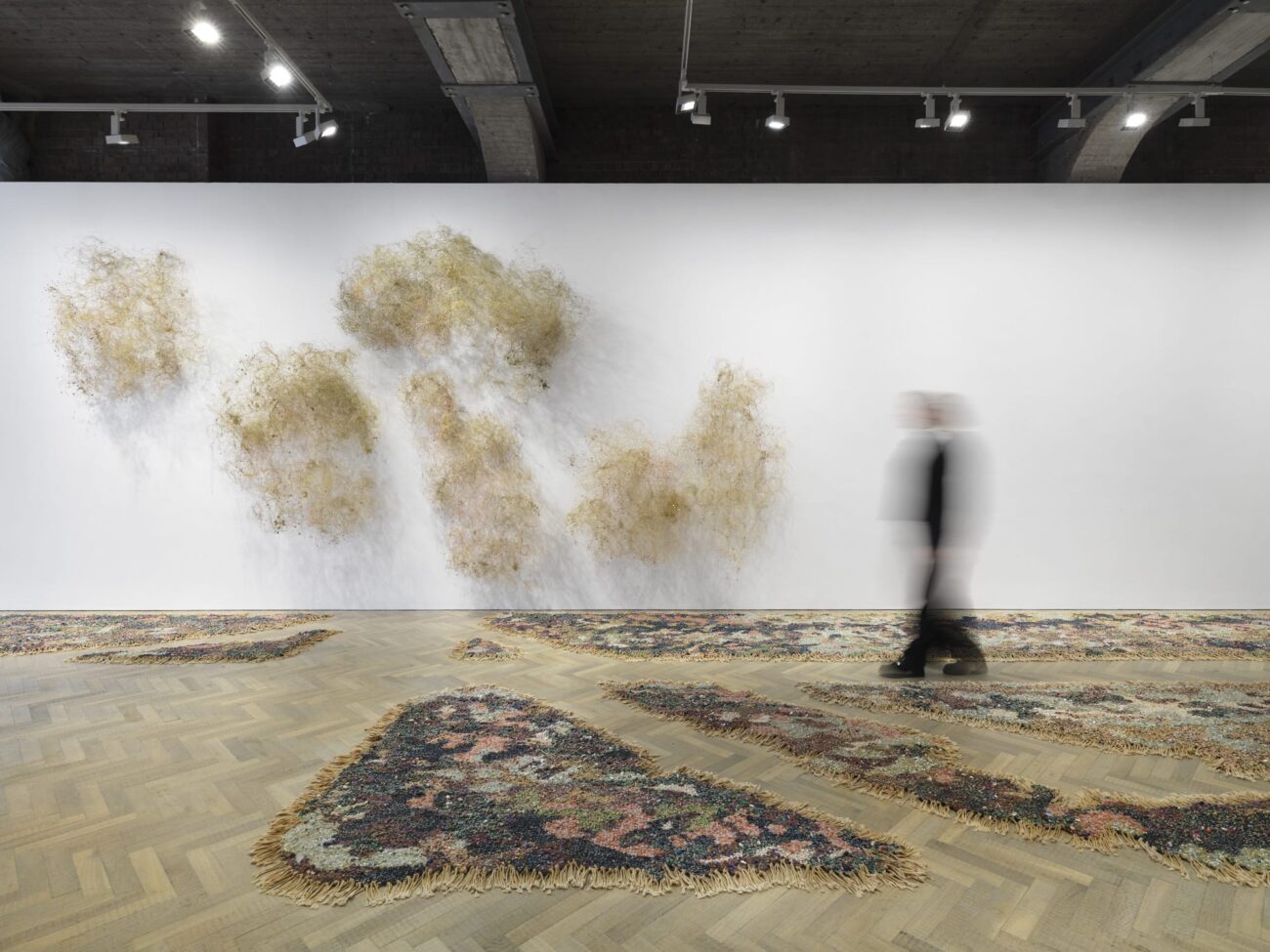
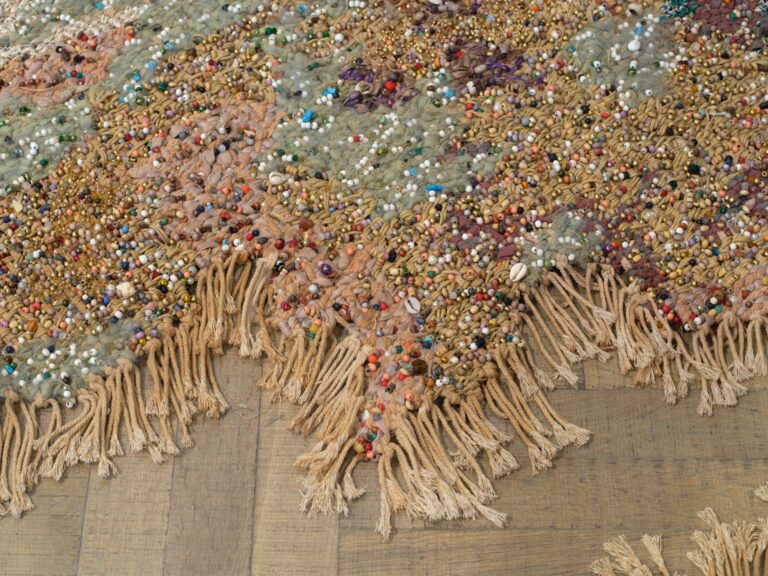
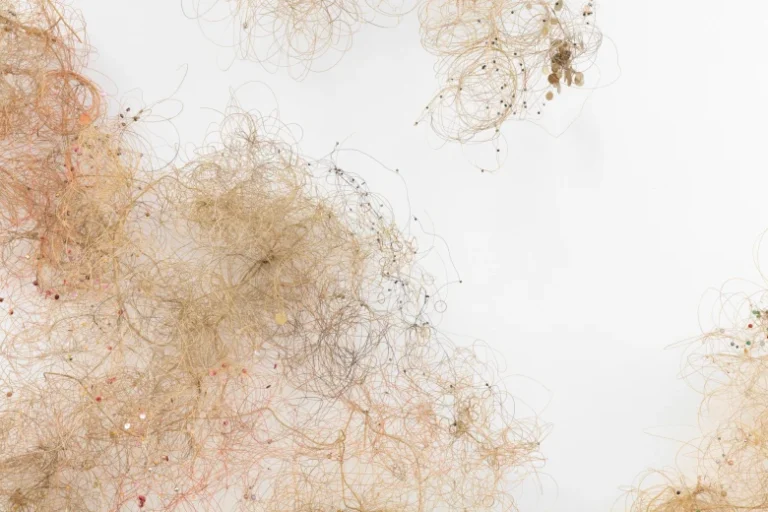
Igshaan Adams’s practice coalesces performance, weaving, sculpture and installation. Born in Bonteheuwel, a township in Cape Town, South Africa, Adams draws upon his background to contest racial, sexual and religious boundaries. This intersectional topography remains visible throughout his practice and serves as a palimpsest upon which traces of personal histories are inscribed and reinscribed. He explains, “I’m interested in the personal stories recorded on the surface. What is recorded is not necessarily always a factual account but can be what is imagined—a combination of myth-making and meaning-making.”
In his 2023 solo show Primêre Wentelbaan, Adams looked at three adjoining locations across Bonteheuwel where he had personally lived, along with the neighboring Heideveld where his aunts lived. The townships are separated by the N2 Highway (previously known as Settlers Way) and Adams traversed these sites in his immediate environment with his brother and friends as he grew from childhood to adolescence and his sense of self was formed. The … floor work Kyk tweekeer vir die karre voor julle kruis! [check twice for the cars before you cross!] (2023), seen above, is connected by absences: pathways that cross the works and chart the movement of people between them.
Here, Adams considers what it means to leave a primary environment behind as a point of origin, and the particular feeling of alienation when returning to these familiar places with an expanded worldview, whilst also grappling with how these environments conditioned and shaped him. The work explores these shifting perspectives. As Adams says, “ultimately, to question these primary points of view is to discover other paths.” (Primêre Wentelbaan, Thomas Dane Gallery, 2023)
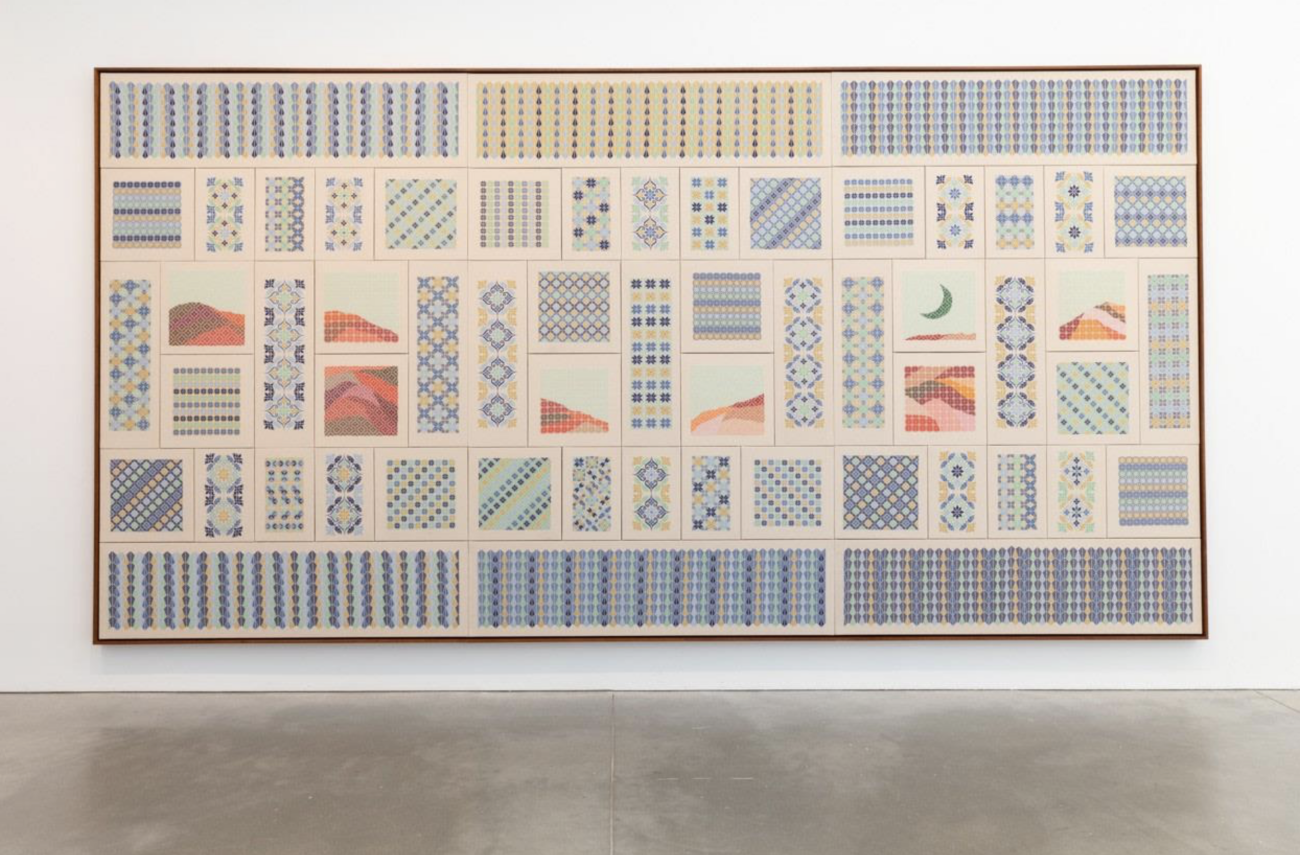
Jordan Nassar’s multivalent art practice engages the material variety of craft to execute ideas centered on heritage and homeland. Through hand-embroidery, wood inlay, glass and expansive installations, he examines issues of identity, diaspora and cultural participation. Nassar often employs “the landscape” as a running thread throughout these different mediums, carefully mapping out patterns and repeatedly intercepting them, using fields of color to define rolling hills and expanses of water. Nassar has adapted the matrilineally-learned tradition of Palestinian tatreez, or cross stitch—most often found on pillows, clothing, and other domestic arts—to mirror his hybridized upbringing. His childhood home in the U.S. was decorated with such objects, which his father brought back from visits to his ancestral homeland. Each hand-embroidered work is stretched and framed, bringing Nassar’s embroidery practice into a dialogue with painting.
Lament of the Field (pictured above) is the artist’s largest such work to date, containing 57 individual panels. The title, culled from Lebanese-American writer Gibran Khalil Gibran (1883–1931) novel A Tear and A Smile (1914), underscores Nassar’s interest in the weaving of past and present; Gibran’s melancholic poetics address the ebb and flow of memory, time, and history. (Jordan Nassar: Fantasy and Truth, The Institute of Contemporary Art, Boston, MA)
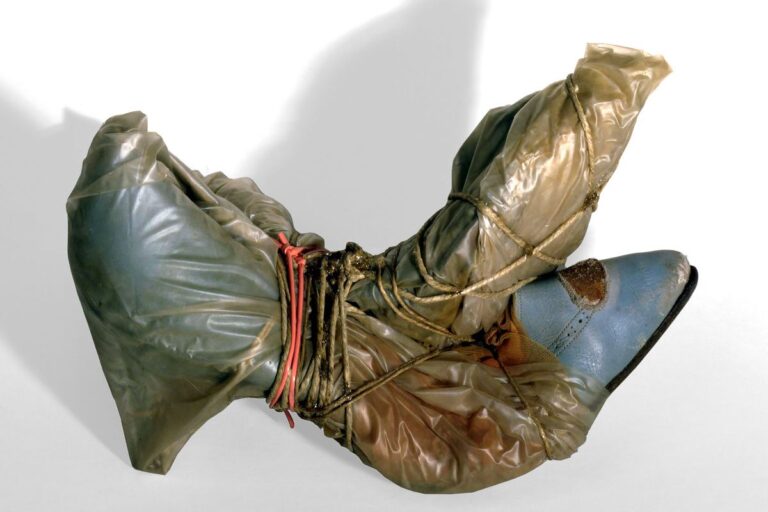
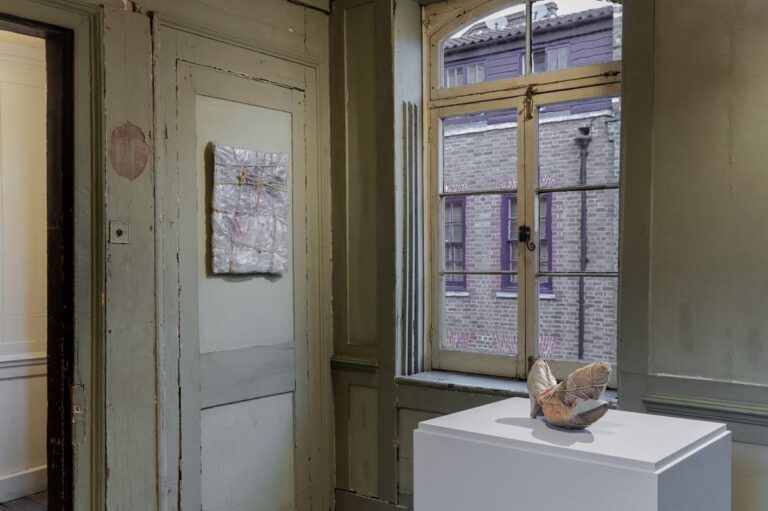
Bulgarian-born conceptual artist Christo first used his later eponymous act of wrapping and packaging to encapsulate the deep relationship between a chosen object and time. J-C’s Wrapped Shoes (pictured above) was recently exhibited in an early eighteenth-century Georgian house. The exhibition, organized by Gagosian Gallery, alluded to the concept of preserving personal possessions, which resonated with Christo’s experience as a political refugee of mixed heritage. This sense of displacement is reflected in the history of the building of 4 Princelet Street, once home to a succession of immigrant families including Huguenot migrants, Irish linen workers, Eastern European Jews and, more recently, the Bangladeshi community.
While his series Packages, Wrapped Objects and Store Fronts were solo projects, all public works and indoor installations, realized and unrealized, were collaborations with his partner and wife Jeanne-Claude. Born on the same day in 1935, the extraordinary couple’s collaborations spanned the globe, and left an indelible mark on art history. From Wrapped Coast, One Million Square Feet, Little Bay, Sydney, Australia (1968–1969) to The London Mastaba, Serpentine Lake, Hyde Park (2016-2018), they challenged conventional art and redefined the relationship between art, people and public space.
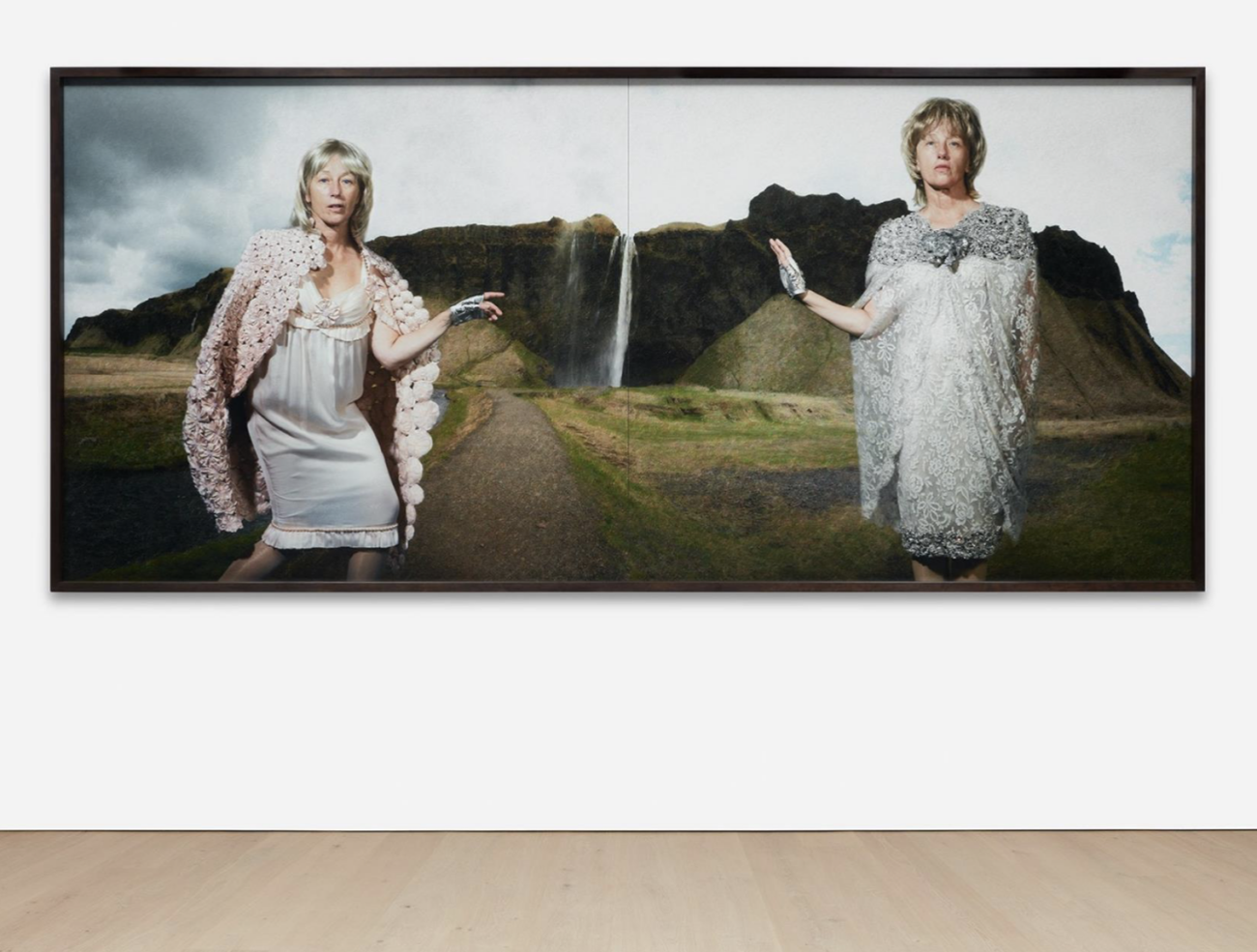
In 2010, POP magazine commissioned Cindy Sherman to create a zine insert for the Autumn/Winter issue of the British fashion publication. For this project, Sherman took up a standing invitation from iconic fashion house Chanel to use their archive. While stranded in Iceland during the 2010 eruption of the Eyjafjallajökull volcano, Sherman photographed herself in front of a green screen in her studio, and then digitally layered the figures over images that she took on the Isle of Capri in Italy. It is clear that Sherman has used Photoshop to manipulate the background, giving it a generic painterly effect—the thickness of the brushstrokes contrasts with ethereal characters standing in the foreground, dressed in Chanel haute couture. The awkward postures undermine our expectations of seamless glamour and introduce a shabby, thrift-shop strangeness to these images.
“I’m trying to erase myself more than identify myself or reveal myself. That’s a big, confusing thing that people have with my work: they think I’m trying to reveal these secret fantasies or something. It’s really about obliterating myself within these characters.” (Cindy Sherman)
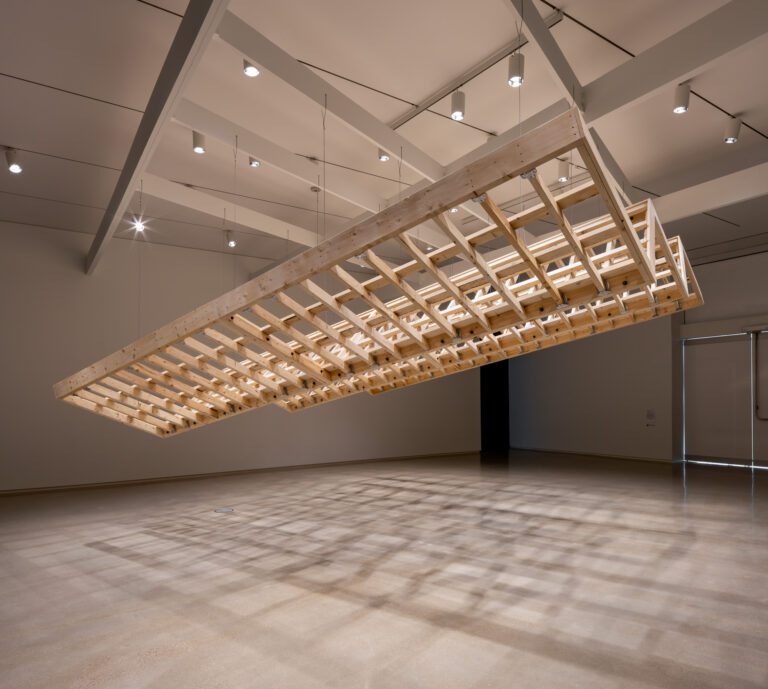
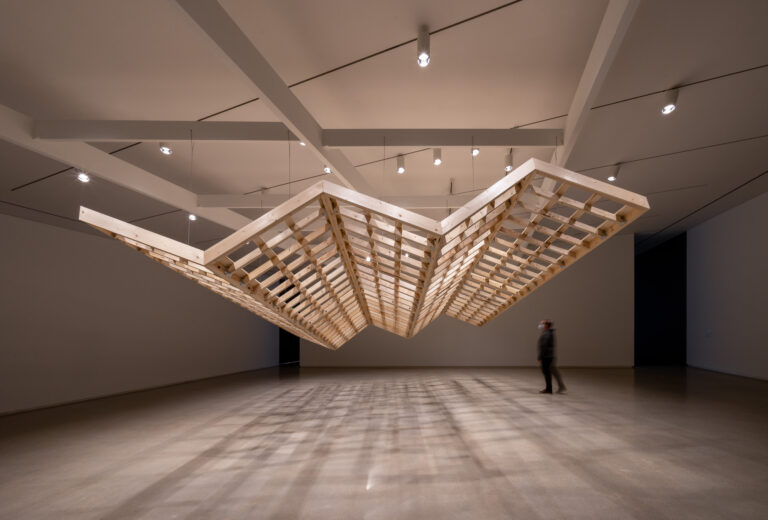
The massive, accordion-like structure of Truck Hunting Out Near Agua Caliente Reservation by interdisciplinary art collective, Postcommodity, is both a playful quip on the metaphorical hunter’s trophy, and a biting critique of postwar sprawl and “anaesthetized” land. Resembling the roof of Donald Wexler’s iconic mid-century modern Steel House on East Simms Road in Palm Springs, California, Postcommodity’s wooden shell belies the reproach of the “progressive design movement,” in which often resulted in empty affordable housing for the rich, and which came to came to drastically subjugate both the land of the Coachella Valley and its Indigenous inhabitants (the Cahuilla).
Like any hunter who is proud of their “kill,” they now display the head like a prized object—made over, reformed… It is a fitting irony; Indigenous homes have been used as museum trophies for over a century. Postcommodity thus return the favour with an act of rasquache, where a narrowly intentioned form is imbued with new meaning and purpose. (Postcommodity: Time Holds All The Answers, Saskatoon: Remai Modern, 2021)

